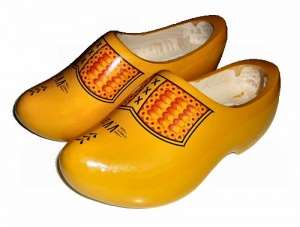Clogs: Difference between revisions
Jump to navigation
Jump to search
Amwelladmin (talk | contribs) No edit summary |
Amwelladmin (talk | contribs) No edit summary |
||
| Line 1: | Line 1: | ||
{{a|work|[[File:Clogs.jpg|thumb|Some clogs, yesterday]]}}{{d|Clogs| | {{a|work|[[File:Clogs.jpg|thumb|Some clogs, yesterday]]}}{{d|Clogs|/klɒgz/|n|}} <br> | ||
1. A robust wooden shoe originating in the low countries, before it found forensic fame and fortune as an arcane {{tag|metaphor}} in the [[courts of chancery]], where one tries where possible to avoid [[Clog on the equity of redemption|clogs on the equity of redemption]]. <br> | 1. A robust wooden shoe originating in the low countries, before it found forensic fame and fortune as an arcane {{tag|metaphor}} in the [[courts of chancery]], where one tries where possible to avoid [[Clog on the equity of redemption|clogs on the equity of redemption]]. <br> | ||
2. A robust wooden shoe from Belgium appropriated by Parisienne weavers — called by them ''un [[Sabotage|sabot]]'' — and thrown angrily into the gears of a new-fangled automatic [[Jacquard loom]] to bugger it up, in a rather [[Cnut]]-like effort to protect their livelihoods. Such mischievous clog-throwing in 19th century Paris became known as “''[[sabotage]]''” but, long-term, didn’t do ''les saboteurs'' much good alas. | 2. A robust wooden shoe from Belgium appropriated by Parisienne weavers — called by them ''un [[Sabotage|sabot]]'' — and thrown angrily into the gears of a new-fangled automatic [[Jacquard loom]] to bugger it up, in a rather [[Cnut]]-like effort to protect their livelihoods. Such mischievous clog-throwing in 19th century Paris became known as “''[[sabotage]]''” but, long-term, didn’t do ''les saboteurs'' much good alas. | ||
Revision as of 19:29, 24 February 2021
|
Office anthropology™

|
Clogs
/klɒgz/ (n.)
1. A robust wooden shoe originating in the low countries, before it found forensic fame and fortune as an arcane metaphor in the courts of chancery, where one tries where possible to avoid clogs on the equity of redemption.
2. A robust wooden shoe from Belgium appropriated by Parisienne weavers — called by them un sabot — and thrown angrily into the gears of a new-fangled automatic Jacquard loom to bugger it up, in a rather Cnut-like effort to protect their livelihoods. Such mischievous clog-throwing in 19th century Paris became known as “sabotage” but, long-term, didn’t do les saboteurs much good alas.